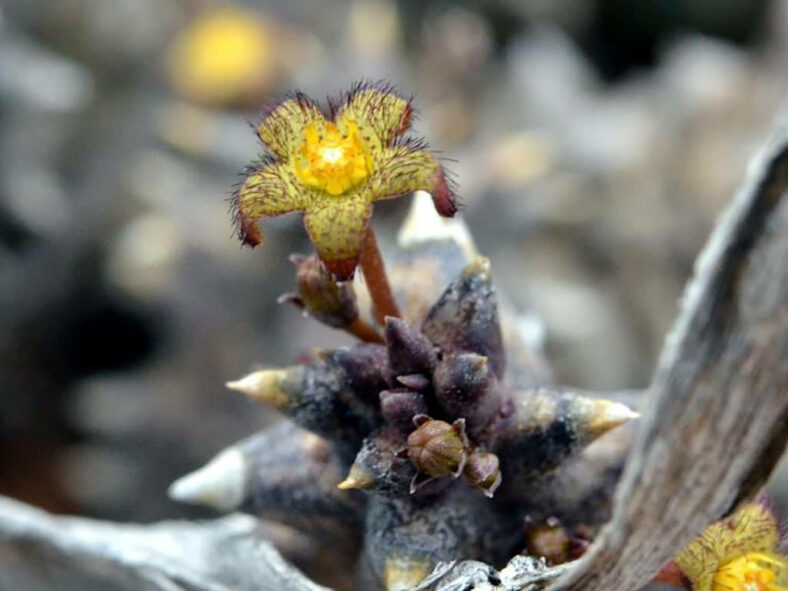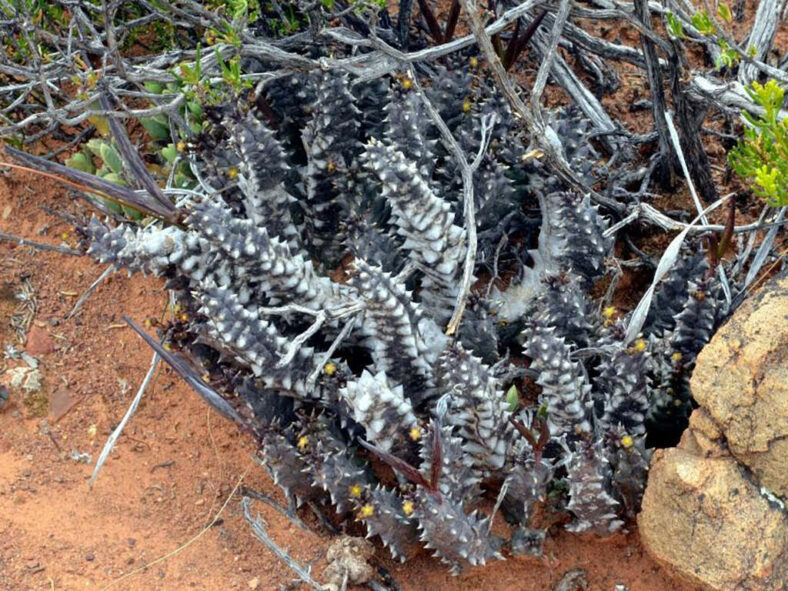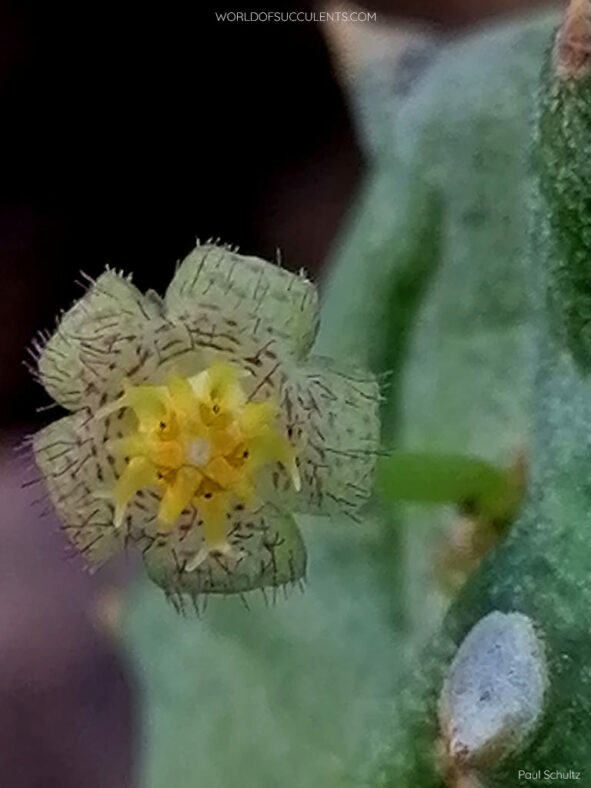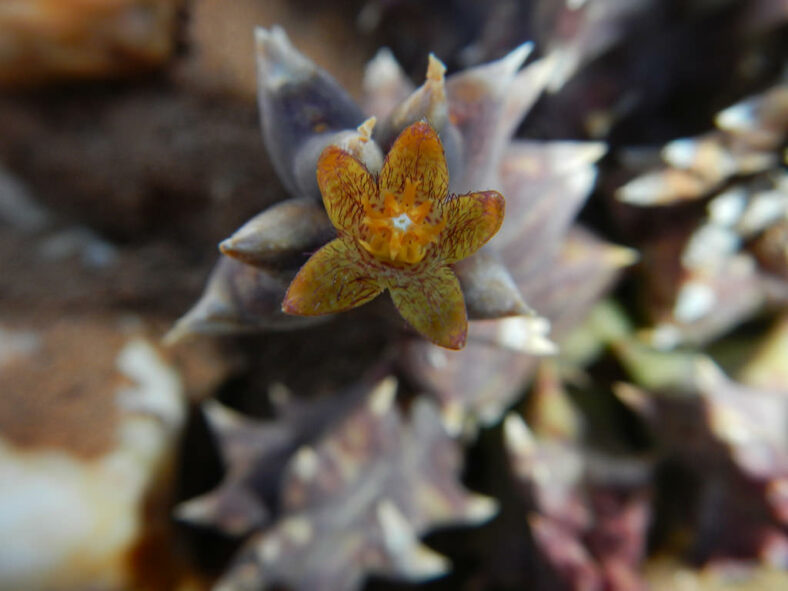Quaqua arida is a clump-forming succulent adorned in fall with small flowers on relatively long, slender pedicels. It was first described by Francis Masson in 1797 as Stapelia arida.
Scientific Name
Quaqua arida (Masson) Plowes ex Bruyns
Synonym(s)
Caralluma arida, Ceropegia arida, Obesia arida, Piaranthus aridus, Stapelia arida
Scientific Classification
Family: Apocynaceae
Subfamily: Asclepiadoideae
Tribe: Ceropegieae
Subtribe: Stapeliinae
Genus: Quaqua
Etymology
The specific epithet "arida" (pronounced AR-id-uh) means "dry, parched, withered, arid" and refers to the arid climate within the range of this species.
Origin
Quaqua arida native to South Africa. It generally occurs in flat, stony, or loamy areas from Loeriesfontein in the Northern Cape to Warmwaterberg in the Western Cape province.
Description
Quaqua arida is a small succulent plant that forms clumps of fleshy, quite stout stems with conical, spreading tubercles joined into four continuous angles along the stem. The stems can be erect or decumbent and grow up to 8 inches (20 cm) long and 1 inch (2.5 cm) thick. They vary in color from green to purplish-green or green, with irregular mottling of purple. Each tubercle is tipped with a sharp, hardened yellow tooth, measuring up to 0.2 inches (0.5 cm) long.
During the fall, Quaqua arida produces inflorescences of 1 to 3 flowers that usually open successively towards the tips of stems. The flowers appear on slender pedicels, which can grow up to 0.6 inches (1.5 cm) long. The corolla can reach a diameter of up to 0.4 inches (1 cm) with lobes spread out and up to 0.25 inches (0.6 cm) with lobes folded back. The outside of the corolla is pale green, while the inside has a solid purple-brown patch in the upper third of each lobe and irregular, pale, transverse, purple-brown bars on a greenish-yellow background on most of the rest. On the inside, there are many stiff, purple or purple-red hairs. Although the corona is small, it is bright yellow, making it relatively conspicuous against the generally faint color of the corolla.

How to Grow and Care for Quaqua arida
Light: Quaqua arida prefers full sun but benefits from light shade on the hottest summer days. Indoors, place the plant near the brightest window in your home, as it will stretch if it doesn't receive enough sunlight. Avoid abruptly moving a plant adapted to lower light levels to full sun to prevent sunburn.
Soil: Use a commercial potting soil mix designed for succulents or prepare your own by mixing 50% to 70% mineral grit, such as coarse sand, pumice, or perlite.
Temperature: The plant thrives in warm outdoor environments with low to moderate humidity. It does not like winter cold and should remain fairly dry and warm during its dormancy. Quaqua arida grows best in USDA Plant Hardiness Zones 11a to 11b, with average minimum winter temperatures ranging from 40 to 50 °F (4.4 to 10 °C).
Watering: It has typical watering needs for a succulent. During the growing season, from spring to fall, water the plant thoroughly and allow the soil to dry between waterings. When it goes dormant in winter, it needs almost no water, about once a month.
Fertilizing: To keep this plant healthy and thriving, fertilize it with water-soluble fertilizer diluted to half the recommended strength. Fertilize the plant only when it is actively growing.
Repotting: Repot Quaqua arida in spring, just before the growing season. It has shallow roots and doesn't require a lot of soil to grow. Always pick a container with drainage holes.
Propagation: The best way to propagate this succulent is by stem cuttings. To ensure good rooting, take cuttings during the growing season. The plant is also easy to start from seeds in spring.
Learn more at How to Grow and Care for Stapeliads.
Toxicity of Quaqua arida
Quaqua arida has no reported toxic effects, so it is safe for growing around children and pets.
Links
- Back to genus Quaqua
- Succupedia: Browse succulents by Scientific Name, Common Name, Genus, Family, USDA Hardiness Zone, Origin, or cacti by Genus
Photo Gallery
Click on a photo to see a larger version.


